
Digital Signage in Schools: Transform Campus Communication and Safety
Remember your school days? Communication probably meant crumpled flyers at the bottom of a backpack, muffled PA announcements, and a bulletin board buried under layers
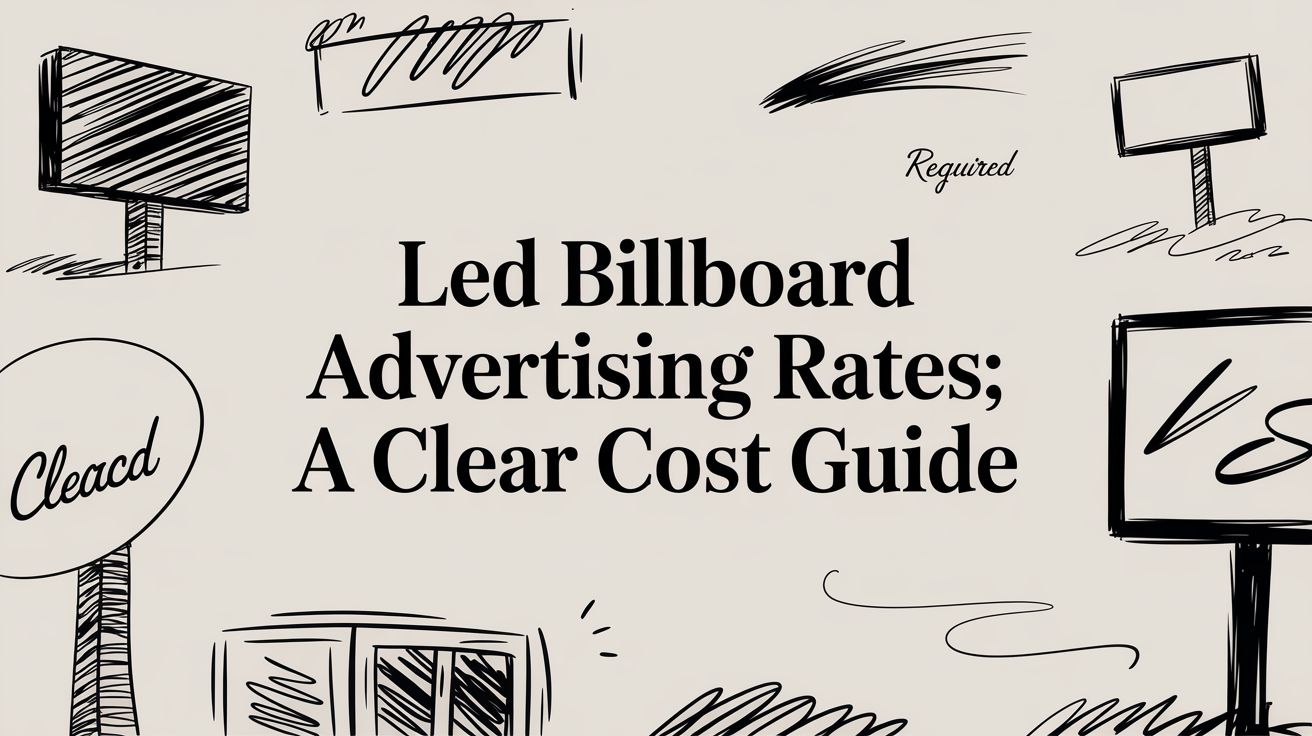
So, you're wondering about the real cost of putting an ad on an LED billboard. The short answer? It can run anywhere from $1,200 a month in a smaller town to over $15,000 in a bustling city center. But the price isn't set in stone; it's shaped by location, how often your ad appears, and the number of eyes your campaign will likely reach.
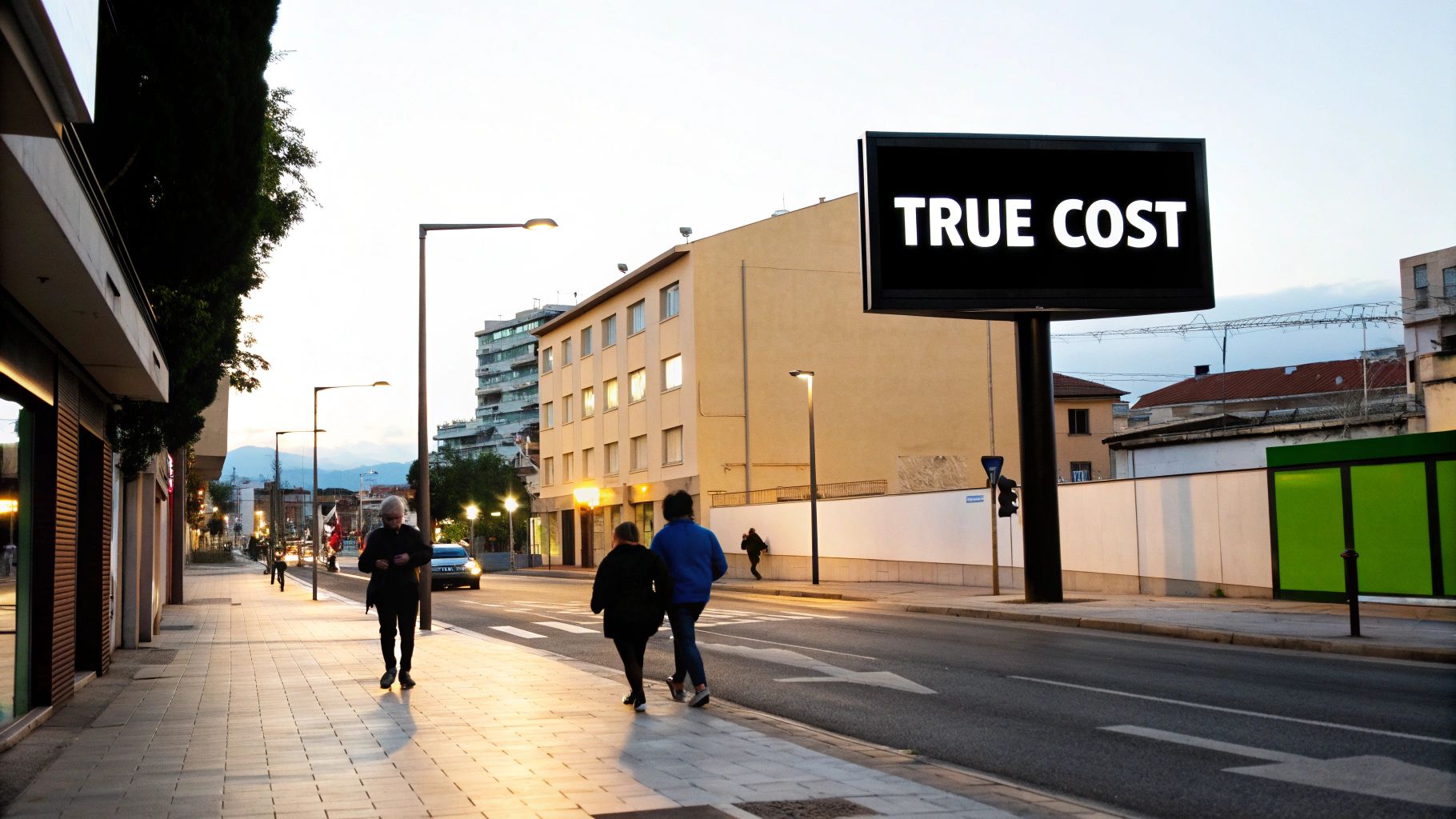
Figuring out the cost of an LED billboard ad isn't like checking a price tag at the store. A better analogy is booking a flight. The price for a seat on the same plane can swing wildly depending on when you buy, your destination, and how many seats are left. In the same way, LED billboard advertising rates are fluid, reacting to a handful of key market forces.
A spot on a digital screen in a quiet suburb will naturally cost less than one overlooking a traffic-jammed highway in a major city. It all comes down to a simple principle: value is based on visibility. The more eyes you can get in front of, the higher the investment.
To give you a clearer picture, let's look at the numbers. Digital LED billboards typically command a 30% to 50% premium over their old-school static cousins, and for good reason—they offer flexibility and a visual punch that static boards just can't match.
For instance, a static billboard in a small town might run you $500–$2,000 per month. Its digital equivalent? Expect something closer to the $1,200–$3,000 range. That price gap gets much wider in big cities, where a prime digital spot can easily rocket past $15,000 per month.
To make this tangible, here are some typical monthly estimates for a standard rotating slot on a digital billboard.
| Market Type | Low-End Estimated Monthly Rate | High-End Estimated Monthly Rate |
|---|---|---|
| Small Town/Rural | $1,200 | $3,000 |
| Medium-Sized City | $3,000 | $6,500 |
| Large Urban Center | $5,000 | $15,000+ |
As you can see, where you advertise matters—a lot. These are just ballpark figures, but they show how much location alone can influence your budget.
The biggest things that will shape your final quote are location, ad frequency (your share of the screen time), and the overall market demand. Getting a handle on these factors is the first real step toward building a realistic budget.
While massive billboards are fantastic tools for grabbing mass-market attention, many businesses are using the same tech on a much smaller scale. On-premise LED signs for businesses work on similar principles, snagging the attention of local foot traffic and drivers right at the point of sale.
The main difference is the audience and the goal. Billboards are all about building broad brand awareness, while a storefront sign is designed to drive immediate, local action—think "Come in for our daily special!" Both, however, depend on bright, dynamic visuals to slice through the noise and get a clear message across. Later, we’ll dig into the specific variables that media owners use to set these rates.
Ever driven past two digital billboards just a few miles apart and wondered why one might cost ten times more than the other? The secret isn’t just “location, location, location”—it's a blend of powerful variables that media owners use to figure out what their ad space is truly worth. Getting a grip on these factors is the key to mastering LED billboard advertising rates.
Think of it like buying a diamond. Its price isn’t just based on sheer size. You're paying for a combination of its cut, clarity, and color. In the same way, a billboard’s price tag is shaped by much more than its spot on a map.
The most fundamental metric in the Out-of-Home (OOH) world is Daily Effective Circulation (DEC). This isn't just a raw count of cars whizzing by. DEC is a much smarter number, estimating how many people are likely to actually see the billboard. It accounts for real-world conditions like traffic speed, visibility, and the angle of the board to the road.
A higher DEC means more potential eyeballs on your ad, which, you guessed it, means a higher price tag. A billboard on a backed-up highway with a 50,000 DEC will always fetch a premium over one on a quiet side street with a 5,000 DEC, even if they’re in the same town.
It's not just about how many people pass by, but how many have a real opportunity to notice your message. High traffic counts are great, but high effective circulation is what you're truly paying for.
While the numbers are crucial, the who is just as important as the how many. Media owners dig deep into the demographics of the people who frequent a particular area. A billboard near a luxury shopping district, a university campus, or a buzzing financial center attracts a very specific crowd, making that space incredibly valuable for the right brands.
Think about these location-based factors:
Beyond where the board is and who sees it, the physical specs of the LED screen itself—and how your ad is shown—play a huge role in the final rate. These technical details directly impact how much punch your campaign packs.
Billboard Size
Bigger is often better, and it's definitely more expensive. A standard 14’ x 48’ bulletin is a classic for a reason—its massive size is just hard to ignore. Smaller formats, like junior posters, are a more budget-friendly route for campaigns focused on a specific neighborhood.
Screen Resolution
The pixel pitch—basically, the density of LEDs on the screen—determines how sharp and clear your creative looks. A high-resolution screen can display crisp, gorgeous visuals, which makes it more engaging and, therefore, more valuable. This is a game-changer for ads that feature detailed product shots or intricate designs.
Ad Frequency (The Loop)
Digital billboards display multiple ads in a rotation, or "loop." A standard loop is usually made up of 6 to 8 advertisers, with each ad getting about 8 seconds of screen time. If you want your ad to show up more often—say, every other slot instead of every eighth—you’ll pay a premium for that bigger share of voice. This is a key negotiating point that lets you balance your exposure with your budget.
The dynamic nature of these screens offers a world of possibilities beyond static posters. Digital LED billboards can run real-time content triggered by weather, sports scores, or local events, creating messages that are hyper-relevant. In fact, survey data shows that 82% of top advertisers see billboards as essential for building brand awareness. The ability to toss in QR codes or social media handles helps connect those offline views with online actions. You can dive deeper into how brands are using billboards to build awareness over on MediaFinch.net.
By understanding these core drivers—circulation, audience, and the display itself—you can start to see why LED billboard advertising rates can vary so wildly. You're not just renting a sign; you're investing in a calculated mix of visibility, audience quality, and technological muscle.
When you start exploring digital ad space, you'll quickly realize that not all LED billboard advertising rates are created equal. Trying to understand the different pricing models can feel a bit like comparing car options: are you leasing, renting by the day, or grabbing a ride-share? Each one serves a different need, and picking the right one is the key to keeping your budget in check while hitting your campaign goals.
Media owners generally sell their ad space in one of three ways, and each has its own logic. Once you get the hang of them, you’ll understand why one quote looks like a simple flat fee while another is priced based on complex audience data. Let's pull back the curtain on these common structures so you can walk into any negotiation with confidence.
This infographic breaks down the core ingredients that media owners stir into the pot when creating these pricing models.
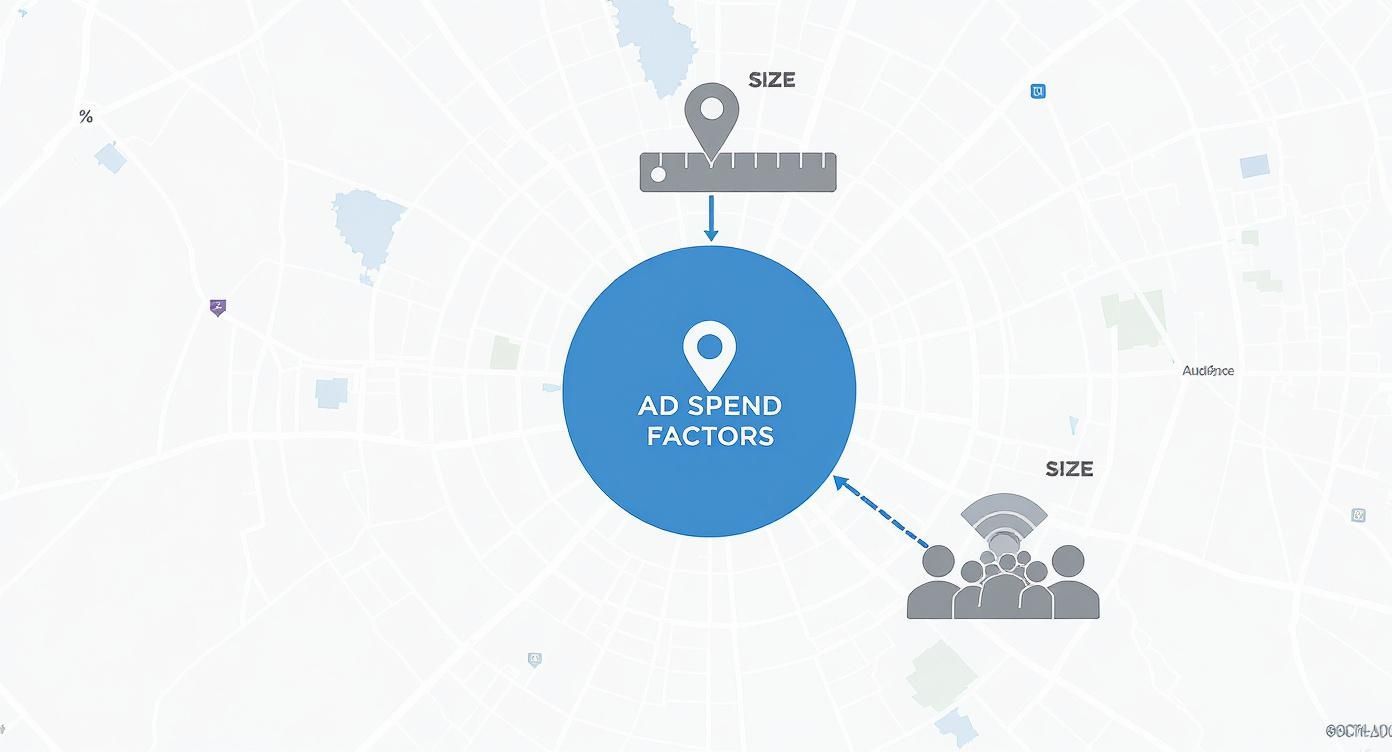
As you can see, what you pay is fundamentally tied to the billboard's location, its size, and the audience it reaches. These are the factors that drive value, no matter which pricing model you're looking at.
The most straightforward way to buy billboard space is the good old flat-fee model. Think of it like leasing a prime retail storefront. You pay a set price for a specific billboard, in a specific location, for a fixed amount of time—usually four weeks or longer.
What you see is what you get. It’s simple and predictable. Your ad is guaranteed a spot in the rotation (often called a "loop") for the entire length of your contract. The price is locked in, which makes budgeting an absolute breeze.
Key Takeaway: The flat-fee model is all about budget predictability and guaranteed placement. It’s perfect for long-term brand awareness campaigns where being seen consistently in one key location is the main objective.
A local car dealership, for example, might book a billboard on a major commuter highway for three months straight. They pay their fixed monthly rate, and their ad runs day in and day out, ensuring thousands of drivers see it over and over again.
As the advertising world gets smarter with data, the Cost Per Mille (CPM) model has really taken hold. "Mille" is just a fancy Latin word for a thousand, so CPM is simply the price you pay for one thousand estimated views, or impressions. If you've ever bought online ads, this will feel very familiar.
Instead of paying for a block of time, you're paying for eyeballs. Media owners use sophisticated data to estimate how many people will likely see the billboard, and your rate is calculated from that audience figure. You’ll often hear an average billboard CPM is around $5, but honestly, this can swing wildly depending on the market.
This model shines when your campaign is focused on maximizing reach across several different locations. It gives you a standard yardstick—the cost to reach 1,000 people—to compare how cost-effective one billboard is versus another.
The newest kid on the block is programmatic Digital Out-of-Home (DOOH), and it's by far the most flexible. It uses automated tech to buy and sell ad space in real-time, kind of like the stock market. Advertisers can bid on specific ad slots based on all sorts of triggers, like the time of day, current weather, or even the type of audience passing by at that exact moment.
Imagine you run a coffee shop. With programmatic DOOH, you could set up a rule to automatically bid on nearby billboards only during the morning commute. Or maybe just when the temperature dips below 50 degrees. That kind of laser-focused targeting was pure science fiction in the OOH world until recently.
This model is built for agile, data-savvy campaigns that need to react on the fly. It's definitely more complex, but programmatic DOOH offers incredible efficiency by making sure your ad only appears when it will have the most impact. Every dollar works harder.
To help you decide which approach is right for your campaign, let's compare these three models side-by-side. Each has its strengths and is suited for different advertising goals.
| Pricing Model | How It Works | Best For | Pros | Cons |
|---|---|---|---|---|
| Flat Fee | Pay a fixed price for a set duration (e.g., 4 weeks) on a specific billboard. | Long-term brand awareness, hyperlocal targeting, campaigns needing consistent presence. | Simple, predictable budgeting. Guaranteed placement and share of voice. | Less flexible. Can't optimize in real-time. Potentially paying for non-peak impressions. |
| CPM | Pay a set rate for every 1,000 estimated impressions the billboard delivers. | Maximizing reach, performance-based campaigns, comparing ad value across different locations. | Pay for audience reach, not just time. Aligns with digital media buying metrics. | Impression data is an estimate. Can be less predictable for budgeting. |
| Programmatic | Use an automated platform to bid on ad slots in real-time based on data triggers. | Hyper-targeted campaigns, short-term promotions, reacting to live events or conditions. | Highly efficient and flexible. Target specific moments and audiences. Minimizes wasted ad spend. | More complex to set up. Bidding can lead to variable costs. Requires more active management. |
Ultimately, the best model depends entirely on what you're trying to achieve. A flat fee gives you stability, CPM gives you a standardized measure of reach, and programmatic gives you surgical precision. Knowing the difference is the first step toward building a smarter, more effective out-of-home advertising strategy.

Alright, let's move from theory to reality. It’s time to roll up your sleeves and actually run the numbers. Calculating your potential campaign costs is what turns those abstract pricing models into a real, tangible budget you can actually work with.
This isn’t just about seeing if you can afford it. This process is your secret weapon for evaluating quotes, comparing different locations, and truly understanding the value you're getting for every dollar spent. Don’t worry, you don’t need an advanced math degree to get this right. We'll break it down into simple steps to build a solid estimate that will guide your decisions and give you confidence when you're negotiating with media owners.
At its heart, the math is surprisingly straightforward. It all comes down to the relationship between the total cost of the ad space and the number of eyeballs it’s expected to reach. This gives us the Cost Per Mille (CPM), a universal metric that lets you compare the efficiency of different ad opportunities on an apples-to-apples basis.
Here are the two fundamental formulas you'll need:
(Number of Billboards) x (Rate Per Billboard Per Period) x (Number of Periods)(Total Cost / Total Impressions) x 1000This framework helps you look past the sticker price and see how cost-effective each potential billboard really is.
Let's make this concrete. Imagine a local restaurant, "The Urban Bistro," wants to run a four-week campaign on a single digital billboard to promote a new lunch special.
Here’s what the media owner tells them:
Now, let's plug these numbers into our formulas and see what the financial picture looks like.
Step 1: Calculate the Total Cost
This part is easy. Since the restaurant is using just one billboard for one four-week period, the math is simple.
1 Billboard x $4,000 x 1 Period = $4,000This $4,000 is the baseline budget for the ad placement itself. If you want to dive deeper into what makes up that final price, from hardware to installation, this complete guide to outdoor LED sign cost is a great resource.
Step 2: Calculate the CPM
Next up, let's figure out how much The Urban Bistro is paying for every 1,000 sets of eyeballs. This is where we measure the campaign's true efficiency.
($4,000 / 500,000 Impressions) x 1000 = $8.00What does this mean? For every $8 the restaurant spends, it’s reaching an estimated 1,000 people. With this CPM number, The Urban Bistro can now compare this billboard to other options. Let's say a second billboard costs less upfront—$3,000—but only delivers 250,000 impressions. Its CPM would be $12. The first billboard, though more expensive at first glance, is actually far more cost-effective when it comes to reach.
By calculating the CPM, you shift the focus from "How much does it cost?" to "What am I getting for my money?" This is the key to making smart, data-driven decisions that maximize your LED billboard advertising rates.
To make this even easier, you can play around with different scenarios using online estimation tools. They can help you model different campaigns in just a few clicks.
Armed with these simple calculations, you can walk into a conversation with media owners holding all the cards. You’ll have a clear understanding of your budget and the value you expect in return, turning a potentially confusing negotiation into a straightforward business discussion based on clear, comparable numbers.
Getting a great billboard location is one thing; getting a great deal on it is something else entirely. You already know what drives LED billboard advertising rates, but turning that knowledge into actual savings? That takes a smarter approach to your budget and negotiation. With the right strategy, you can stretch every dollar and make sure your investment delivers the biggest possible impact.
Think of it like buying a car. The sticker price is just a suggestion, right? Smart buyers know there are always ways to negotiate, bundle services, or find discounts that aren't plastered on the windshield. The Out-of-Home (OOH) advertising world works the same way—a little prep work can lead to some serious savings.
When you walk in with a clear plan and a solid grasp of the market, you immediately have the upper hand. Instead of just taking the first quote you're given, you can start a real conversation that ends with a much better deal. It's all about showing them you're a serious, well-informed buyer.
Here are a few proven tactics to get more bang for your buck:
Before you sign on the dotted line, you need to be crystal clear on what you’re paying for. Hidden fees and inflexible terms can quickly sour a seemingly great deal. Arm yourself with these questions to make sure you're getting full transparency.
A great rate means nothing if it’s loaded with hidden costs or restrictive terms. Your goal is to find a true partner who offers both a fair price and the flexibility your campaign needs to succeed.
Make sure you get straight answers to these questions:
Getting these details sorted is non-negotiable for anyone looking to invest effectively in digital outdoor signage.
This strategic approach is more critical than ever as the market continues to expand. Billboard advertising is still a massive piece of the global OOH puzzle, with digital screens fueling most of the growth. In 2024, digital billboards pulled in roughly 41% of worldwide OOH revenue, which works out to about $20 billion. The entire billboard market is set to grow from $60.7 billion in 2024 to $62.5 billion in 2025, proving it’s as resilient as ever. By negotiating smartly, you ensure your investment is a sound one in this thriving industry.
So, your billboard is up, and it looks incredible. Now for the million-dollar question: how do you prove an offline ad channel is actually working? Measuring your return on investment (ROI) is the final, crucial piece of the puzzle, turning your ad spend from a hopeful guess into a measurable business driver.
Answering the ROI question used to be a major headache for advertisers. These days, though, a mix of time-tested tactics and modern tech makes it easier than ever to connect the dots between your billboard and your bottom line. With the right strategy, you can get a surprisingly clear picture of your campaign's impact.
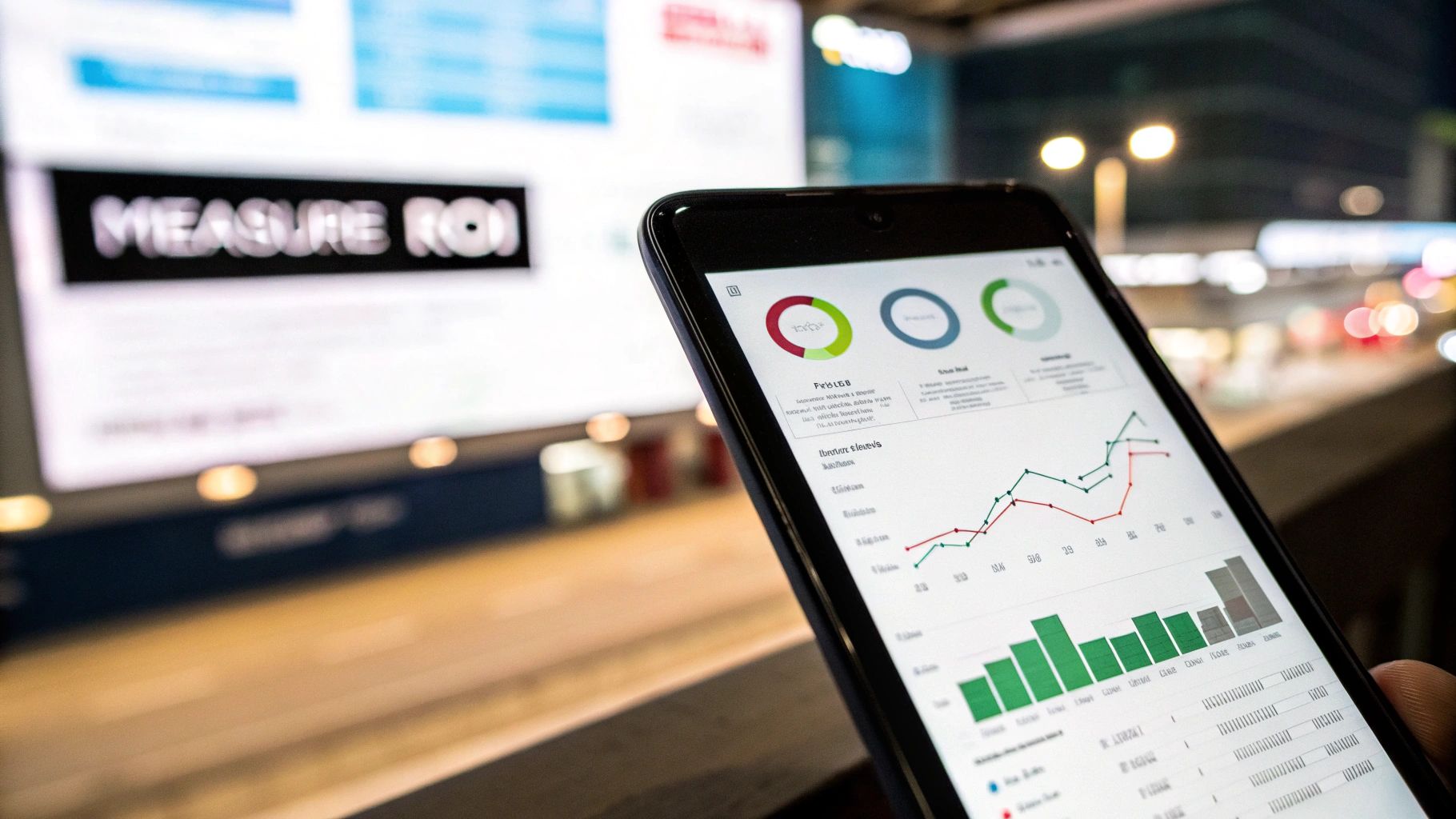
The simplest way to measure impact is to give viewers a unique, trackable action to take. Think of it as creating a dedicated bridge from your physical ad to your digital world. This approach gives you clear, direct evidence of who is responding to your campaign.
These methods are so effective because they are exclusive to your billboard:
YourBrandDeals.com) that redirects to a specific landing page. Your website analytics will show you exactly how many people typed in that URL.By isolating the call to action, you can confidently attribute website visits, sales, and phone inquiries directly back to your billboard investment. This removes the guesswork and provides hard data on campaign performance.
Beyond direct response, new technologies allow for a much more sophisticated look at your billboard's influence on consumer behavior. These methods help you see the bigger picture of how your ad is lifting brand awareness and driving real-world actions.
For example, geofencing has become an incredibly powerful tool. By creating a virtual perimeter around your billboard, you can analyze anonymous mobile device data to measure the lift in foot traffic to your physical store from people who were exposed to the ad. This gives you concrete data on whether your billboard is successfully getting people through your doors.
You can also monitor digital trends during your campaign. Look for spikes in branded web searches (people Googling your company name) in the geographic area surrounding the billboard. A noticeable jump in search volume is a strong indicator of rising brand awareness. Finally, throwing a QR code on your creative offers a direct, low-friction path for viewers to visit your website, download an app, or access a promotion instantly with their smartphone.
Diving into the world of LED billboard advertising can stir up a lot of questions. As you get closer to pulling the trigger on a campaign, it’s completely normal to wonder about the price differences, short-term rental options, and any extra costs that might not be on the initial quote. Let’s clear up some of the most common things people ask.
One of the first questions we always hear is why digital billboards cost more than the old-school static ones. You can expect digital displays to run 30% to 50% higher because you're paying for so much more than just ad space. You’re really investing in flexibility, eye-popping vibrancy, and the power to run dynamic content that a printed vinyl sign just can't compete with.
Absolutely. This is where programmatic DOOH really shows its strength. While traditional billboard contracts often lock you in for at least four weeks, programmatic buying gives you incredible freedom. You can easily book ad space for a single day, a weekend, or even just a few hours during rush hour.
This short-term approach is a perfect fit for:
Yes, and it's smart to look beyond the base rental fee to get the full picture of your total investment. While they aren't always "hidden," some additional costs are easy to miss if you're not looking for them.
Always ask for a fully itemized quote that breaks down every single potential charge. A trustworthy media partner will have no problem laying it all out for you. This ensures there are no surprises down the road, and you can accurately track your campaign's financial performance.
Here are a few key costs to ask about:
Understanding the true financial return on your investment is crucial for any ad spend, and LED billboards are no exception. For some proven strategies on this, you can learn how to measure marketing ROI effectively. By getting clarity on these points upfront, you can build your budget with total confidence.
At Smart LED Inc., we believe in being completely transparent and empowering our clients with the best visual solutions out there. From massive digital billboards to vibrant storefront signs, we provide factory-direct pricing and expert guidance to make sure your message gets seen. Explore our high-impact LED displays and start building your next campaign today at https://smartledinc.com.

Remember your school days? Communication probably meant crumpled flyers at the bottom of a backpack, muffled PA announcements, and a bulletin board buried under layers

At its core, an LED screen for stage is a massive digital canvas built to create jaw-dropping backdrops, show live video, and unleash stunning visual
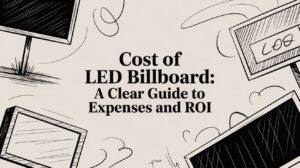
The cost of an LED billboard can be anywhere from $30,000 for a smaller, simpler display to well over $500,000 for the massive, high-definition screens
"*" indicates required fields